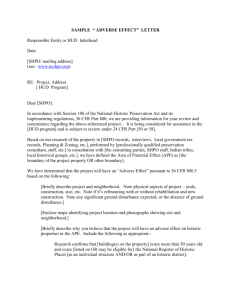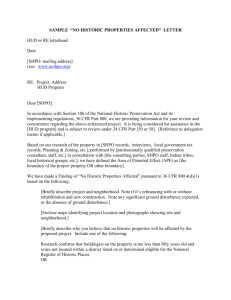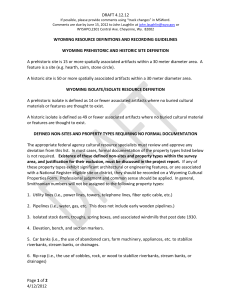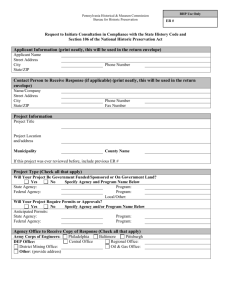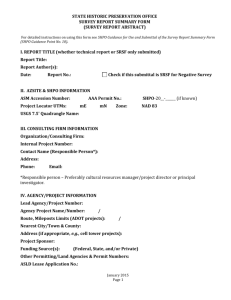DRAFT 4.12.12 If possible, please provide comments using “track
advertisement
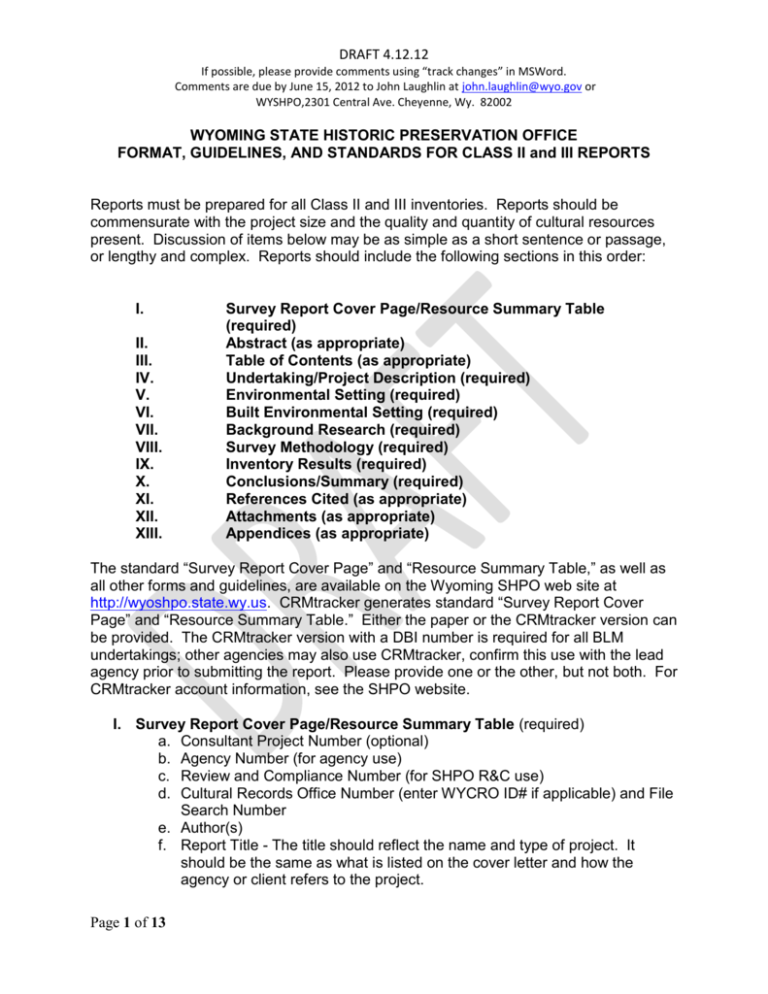
DRAFT 4.12.12 If possible, please provide comments using “track changes” in MSWord. Comments are due by June 15, 2012 to John Laughlin at john.laughlin@wyo.gov or WYSHPO,2301 Central Ave. Cheyenne, Wy. 82002 WYOMING STATE HISTORIC PRESERVATION OFFICE FORMAT, GUIDELINES, AND STANDARDS FOR CLASS II and III REPORTS Reports must be prepared for all Class II and III inventories. Reports should be commensurate with the project size and the quality and quantity of cultural resources present. Discussion of items below may be as simple as a short sentence or passage, or lengthy and complex. Reports should include the following sections in this order: I. II. III. IV. V. VI. VII. VIII. IX. X. XI. XII. XIII. Survey Report Cover Page/Resource Summary Table (required) Abstract (as appropriate) Table of Contents (as appropriate) Undertaking/Project Description (required) Environmental Setting (required) Built Environmental Setting (required) Background Research (required) Survey Methodology (required) Inventory Results (required) Conclusions/Summary (required) References Cited (as appropriate) Attachments (as appropriate) Appendices (as appropriate) The standard “Survey Report Cover Page” and “Resource Summary Table,” as well as all other forms and guidelines, are available on the Wyoming SHPO web site at http://wyoshpo.state.wy.us. CRMtracker generates standard “Survey Report Cover Page” and “Resource Summary Table.” Either the paper or the CRMtracker version can be provided. The CRMtracker version with a DBI number is required for all BLM undertakings; other agencies may also use CRMtracker, confirm this use with the lead agency prior to submitting the report. Please provide one or the other, but not both. For CRMtracker account information, see the SHPO website. I. Survey Report Cover Page/Resource Summary Table (required) a. Consultant Project Number (optional) b. Agency Number (for agency use) c. Review and Compliance Number (for SHPO R&C use) d. Cultural Records Office Number (enter WYCRO ID# if applicable) and File Search Number e. Author(s) f. Report Title - The title should reflect the name and type of project. It should be the same as what is listed on the cover letter and how the agency or client refers to the project. Page 1 of 13 DRAFT 4.12.12 If possible, please provide comments using “track changes” in MSWord. Comments are due by June 15, 2012 to John Laughlin at john.laughlin@wyo.gov or WYSHPO,2301 Central Ave. Cheyenne, Wy. 82002 g. Date of Report h. Lead Agency (e.g. BLM Rawlins, BLM Buffalo, WYDOT, DEQ, Medicine Bow National Forest … SHPO is NEVER a lead agency) i. State the name of the cultural resource consulting company. j. Brief Description of Undertaking - Briefly describe the type of action. k. Federal Permit Number and expiration date if applicable. l. Survey Methods- Check the transect width (in meters) and check or enter the width of linear corridor (in feet) m. County n. USGS Quad Maps - Provide the names of all the maps used. o. Landowner/Federal Land Managing Agency - Identify the owner(s) of land involved in the undertaking. p. Legal Description -- Please provide township, range, and section(s) with ¼ location descriptions of the undertaking. The ¼ locations should describe the area covered by the inventory. General ¼ locations are acceptable for projects such as transmission lines, seismic lines, or pipelines. Note template corner and/or section line used. Always use the section corner closest to the cultural resource regardless of section shape. UTMs should be used where there is no cadastral survey e.g. Yellowstone National Park. q. Acreage - The acreage numbers should be calculated for the federal/nonfederal and block and linear inventory. Total acreage should report the entire acreage involved in the survey. Please report total acreage per landowner/land manager if applicable (e.g. BLM 25 acres, State 14 acres, private 7 acres, total = 46 acres). Please also include a breakdown for each BLM Field Office, Forest, etc. if applicable. r. File Search Date – File searches should be conducted no more than 60 days prior to your fieldwork date. s. Fieldwork Date - Indicate beginning and ending fieldwork dates. t. Field Personnel - List the crew chief and all field personnel. u. Survey Results - Please indicate whether cultural material was found on the survey. Put the total number of isolated finds/isolated resources and number of sites in the APE (i.e. located during the literature/files search as well as on-the-ground survey) in the spaces (not just a check mark). v. Resource Summary Table - The field agent is required to fill out the resource summary table. II. Abstract (Abstracts are appropriate for large projects and should include the following information. For example, a 10 acre well pad report does not require an abstract. If you have questions, ask the lead agency about the need for an abstract.) a. Type of Project/Action (e.g. road construction, timber sale, well pad and access, etc.) b. Type of Investigation (Class II or III) Page 2 of 13 DRAFT 4.12.12 If possible, please provide comments using “track changes” in MSWord. Comments are due by June 15, 2012 to John Laughlin at john.laughlin@wyo.gov or WYSHPO,2301 Central Ave. Cheyenne, Wy. 82002 c. General Project Location for rural projects (Drainage Basin, Major Geographic Area) d. Urban inventories should include a sentence on the built environment. e. Summary of Results III. Table of Contents (Appropriate for large projects.) IV. Undertaking/Project Description a. Describe the type of project (describe proposed project e.g. well pad, pipeline, aggregate pit, coal mine, etc.) and the elements of the project (e.g. four wells, three miles of access road, and one mile of buried pipeline.) Include the total acreages involved; specify the length and width of linear projects. Also include the height, mass, and any auditory or atmospheric issues created by the undertaking. For example: i. “The project involves the construction of a well pad and access road. An inventory was conducted of a 10 acre area centered on the well pad and an access road 1 mile in length and 50 feet wide on either side of the centerline for a total 100 foot corridor. After completion of drilling, the well will stand 20 feet tall,..” b. Describe the area and nature of the anticipated disturbance if any or if known (e.g. drill pads, surface blading, lay-down and staging areas, trenching, recontouring, open pit mining.) c. Describe the area of potential effect (APE) as determined by the lead federal agency including any considerations for indirect effects such as visual, auditory, or atmospheric. This description should include how the APE was defined by the lead agency; consultants should contact the lead agency for this information. Note: The APE is influenced by the scale and nature of an undertaking and may be different for different kinds of effects caused by the undertaking. The direct impact project area is only a portion of the APE; the APE must include areas of indirect effect. In some situations, such as a Section 110 inventory or a planning survey, there may not be an APE. If this is the case, state the reason that no APE is defined in the report. i. A map marking the APE must be submitted. The map should be of an appropriate size and scale to adequately show the undertaking and the APE. d. Describe the total acreages of survey, and describe sizes of survey elements such as well pad blocks and linear surveys. Describe relationship of survey area to APE and any special inventory strategies for indirect effects. e. Provide general overview photograph(s) of the proposed project area. These photographs shall be at least 3.5 inches by 5 inches in size. (Digital photos are acceptable. See “Wyoming SHPO Photographic, Archival, and Digital Submission Standards for Reports and Site Forms” Page 3 of 13 DRAFT 4.12.12 If possible, please provide comments using “track changes” in MSWord. Comments are due by June 15, 2012 to John Laughlin at john.laughlin@wyo.gov or WYSHPO,2301 Central Ave. Cheyenne, Wy. 82002 (http://wyoshpo.state.wy.us/pdf/PhotographicStandards.pdf) for detailed information and instructions.) f. Provide a high quality copy of a 1:24,000 scale standard 7.5’ USGS topographic map for the undertaking. Do not enlarge or reduce the 1:24,000 scale map(s). The 1:24,000 scale map(s) should illustrate the inventory area, the resource locations (newly identified and previously recorded), project footprint, and lead agency defined APE. Ensure that each map is labeled with legal coordinates and legends as appropriate. Include highlighted areas as needed to help illustrate project and resource areas. Topographic lines should be visible. Maps should not be cropped to an individual section but should show as much area as possible around the inventory area. Supplemental maps which are enlarged or reduced are often necessary to enhance the illustration of the project or property areas and, if not already submitted, will be requested by SHPO. V. Environmental Setting (of the APE) – * for undertakings in urban areas, this section is not necessary *. a. Present Environment i. Describe the general physiographic area (reference the Wyoming Geographic Landforms Map) 1. http://wyoshpo.state.wy.us/Images/geomap.jpg ii. Project Area Description (include specific reference to the APE when appropriate) 1. Geology: Formations (see Love and Christiansen; Lageson and Spearing) exposed at the surface and their influence on local topography and landforms 2. Hydrology: Primary trunk, local drainage patterns, and surface water sources 3. Depositional Settings a. nature of surface deposits (i.e. alluvial, colluvial, aeolian, etc.) and their distribution on the landscape b. potential for buried cultural materials 4. Vegetation a. general plant communities (Knight 1994) b. general surface visibility iii. Discuss any constraints on discovery and preservation Discuss factors which may have affected the discovery and preservation of cultural resources (e.g., lighting conditions, mud, snow cover, fire, erosion, livestock, cultivation, construction; describe any previous disturbance.) VI. Present Built Environmental Setting 1. What is visible from and within the APE? Generally describe the surroundings and visible manmade features (e.g. these might include Page 4 of 13 DRAFT 4.12.12 If possible, please provide comments using “track changes” in MSWord. Comments are due by June 15, 2012 to John Laughlin at john.laughlin@wyo.gov or WYSHPO,2301 Central Ave. Cheyenne, Wy. 82002 roads, fences, windmills, buildings, structures, modern oil field development, highways, etc.). 2. Include a representative photograph(s) of the surrounding landscape. VII. Background Research 1. Resources to be consulted must include a file search from the Wyoming SHPO’s Cultural Records Office (WYCRO), GLOs (access the GLOs at http://www.wy.blm.gov/cadastral/surveydocs.htm) and appropriate responsible agency (ies) records. It is not necessary to include the printed WYCRO file search in the Class II or III report. Summarize the type and nature of previous inventories. In general, a project-by-project description of the previous inventories is neither necessary nor desired. Indicate if portions of the APE have been previously inventoried. Provide rationale if any areas were re-inventoried for the current APE. For example: i. The WYCRO file search (#00001 on 3/10/12) lists seven surveys; three are well pads totaling 30 acres, located in the north half and south half of the SW of the section, and four are linear projects of which two are located in the SE 1/4 crossing the current APE. A portion of the NW ¼ of the APE was previously inventoried in 1978. This inventory does not meet current professional standards. No resources have been previously recorded in the APE. Three previously recorded resources are reported on the file search. Resources 48XY### and 48XY### are located more than one half mile to the west of the current APE and are previously evaluated, with SHPO concurrence as not eligible for inclusion to the NRHP. They are both small prehistoric lithic scatters. Resource 48 XY### is a contributing segment of the Oregon-California-Mormon Pioneer National Historic Trail. It is one third mile from the APE to the east. This segment of trail has been recorded and evaluated on two separate field visits in 1988 and 1999. Further discussion of project effect to this resource can be found in section VIII.B of this report. ii. The file search should be broad enough to include an APE for indirect effects (again, the indirect APE is determined by the lead agency through consultation with SHPO and other interested parties) note: files search for the indirect APE can be done on-line for no fee. 2. The file search should help identify property types such as sites, districts, buildings, structures, objects, and landscapes in the indirect APE such as ranches, historic trails, mining districts, traditional cultural properties (tcps), sites of potential religious and cultural significance (e.g. rock art, cairns) to Indian Tribes, and known burial sites. Each property must be identified and described, and the indirect effects must be discussed when the property (ies) occurs in the APE. Page 5 of 13 DRAFT 4.12.12 If possible, please provide comments using “track changes” in MSWord. Comments are due by June 15, 2012 to John Laughlin at john.laughlin@wyo.gov or WYSHPO,2301 Central Ave. Cheyenne, Wy. 82002 3. Discuss additional sources of information consulted. These might include aerial photographs, other land records, planning documents, and other sources suggested or required by the responsible agency(ies). 4. If appropriate, discuss how the lead agency has either directly or through the cultural consultant sought information, as appropriate, from consulting parties, and other individuals and organizations likely to have knowledge of, or concerns with, historic properties in the area. (36 CFR Part 800.4(a)3). 5. Identify previously recorded cultural resources and eligible resources that may be affected by the project. i. Discuss known resource types. ii. Discuss previous eligibility determinations (specify criteria of eligibility). iii. Discuss proximity of eligible properties to the APE (explicitly indicate if the cultural resources identified are within the APE). 6. Provide a context relative to resources that may be anticipated in the project area. Please reference and review available contexts on the WYSHPO website at http://wyoshpo.state.wy.us/HC/Available.aspx i. Discuss known resource density. ii. Discuss cultural affiliation/historical themes of known resources. Address these factors to the degree they are applicable and necessary to support evaluations and recommendations. iii. Discuss the chronological placement and environmental setting of resources. Address these factors to the degree they are known or to the degree necessary to support evaluations and recommendations. (e.g., Late Archaic resources in this area tend to be located in sand dunes.) iv. Discuss, based on cultural affiliation/historical themes and placement, whether or not these resources should be evaluated as a district and/or landscape. 7. Provide historical contextual information relative to resources that may be anticipated in the project area. This discussion should be scaled to the undertaking and the resources encountered. Refer to National Register Bulletin: How to Complete the National Register Registration Form, page 4 and National Register Bulletin: How to Apply the National Register Criteria for Evaluation, pages 7-10 for guidance on historic contexts relative to specific properties. Also refer to the WYSHPOs context program website for existing historic contexts, see website link above. i. Discuss history of project area relative to resources that may be anticipated in the project area. This is necessary to understanding the property’s significance and to determining a period of significance. ii. Discuss the property types – contextual information for homesteads, for instance, etc. Page 6 of 13 DRAFT 4.12.12 If possible, please provide comments using “track changes” in MSWord. Comments are due by June 15, 2012 to John Laughlin at john.laughlin@wyo.gov or WYSHPO,2301 Central Ave. Cheyenne, Wy. 82002 8. Discuss historic research as appropriate. Properties eligible under criteria A, B, and/or C generally require additional research (these include homesteads, ranches, trails, roads, canals, etc.). Typical sources include county records, county libraries, local museums, Wyoming State Archives, the American Heritage Center at the University of Wyoming. To complete this section, please see National Register Bulletin: Researching a Historic Property. i. Discuss types of historical records reviewed and where they are stored. ii. Provide names and addresses of individuals contacted if applicable. 1. It may be necessary to contact the landowner regarding the history of resources for undertakings where these resources occur on private land. iii. Provide appropriate citations of references used. iv. Discuss the limitations, accuracy, and biases of the archival research. Note: If VI.F.1-4. is not addressed in the report, SHPO will assume the research has not been done and will request that it be completed. VIII. Survey Methodology 1. Extent of Survey Coverage i. Pedestrian Coverage 1. Transect width (if non-standard, describe and justification should include authorization from federal agency, if applicable.) 2. Describe other types of coverage (examined cut banks, rodent burrows, road cuts, animal trails, etc.). ii. Supplemental coverage 1. Remote Sensing 2. Airplanes or helicopters (In general, this is used for historic trails) 3. Describe any other type of non-traditional discovery methods used. 2. If applicable, describe the collection strategy. Specific artifact collection policies are determined by the responsible lead agency. Check with the lead agency to determine collection policies prior to fieldwork. i. State the disposition of artifacts, photographs, notes, specimen samples, etc. Name the curation facility used. Name where other field notes, photos, and documents can be obtained and accessed. State if the private surface owner has requested artifacts be returned or if the artifacts will be or have been donated to a curation facility. Page 7 of 13 DRAFT 4.12.12 If possible, please provide comments using “track changes” in MSWord. Comments are due by June 15, 2012 to John Laughlin at john.laughlin@wyo.gov or WYSHPO,2301 Central Ave. Cheyenne, Wy. 82002 3. Discuss resource mapping methodology (techniques, equipment) 4. Discuss testing strategy (if applicable) i. Shovel testing ii. Auger testing iii. Backhoe trenching (if approved by agency) 5. Provide a brief discussion of weather and ground conditions at the time of the survey (e.g., if overcast and foggy with 10 percent snow cover) i. To what extent did field conditions alter methods? ii. To what extent did field conditions alter results? IX. Inventory Results (this includes all resources within the APE, including those found during the files search/literature review as well as on the ground survey) 1. Summarize Cultural Resource Findings (e.g. 23 resources were recorded, 19 prehistoric and four historic; nine IRs were recorded, eight prehistoric and one historic. Two prehistoric resources were re-evaluated) 2. Resource Descriptions (Each individual resource should be discussed separately using the following format. Include the Smithsonian Trinomial Number. Discuss properties in alphanumeric order. Repeat VIII.B 112 as necessary for each resource.) i. General topographic location ii. Landownership (e.g. BLM, private, split-estate) iii. Size (length, width, total area) iv. Physical remains v. Cultural affiliation (if known) vi. Condition vii. Testing viii. Assessment of potential threats to the resource ix. Sketch map - illustrate the following as appropriate: 1. Areas tested 2. Resource boundaries 3. Resource orientation (north arrow) 4. General artifact distribution 5. Features and/or concentrations of artifacts 6. Diagnostic artifacts 7. Collected artifacts 8. Resource datum 9. Pertinent physiographic features (i.e., schematic topographic lines, drainages, depressions, outcrops, modern features, and disturbances) 10. Map key (explain all symbols) 11. Smithsonian Trinomial number 12. Scale Page 8 of 13 DRAFT 4.12.12 If possible, please provide comments using “track changes” in MSWord. Comments are due by June 15, 2012 to John Laughlin at john.laughlin@wyo.gov or WYSHPO,2301 Central Ave. Cheyenne, Wy. 82002 13. Relationship to APE and relationship to anticipated disturbance, if known. 3. Resource photographs (see standards at http://wyoshpo.state.wy.us/photo.htm) i. Resource overview photographs with scale. For large projects, you may provide a sample set of photographs as appropriate to illustrate representative types of resources found on the project inventory. ii. Feature photographs as appropriate with scale. iii. Photographs or line illustrations of diagnostic artifacts with a professional quality scale (i.e. no pennies, pens, pencils, etc used for scale). iv. If setting is an important consideration for determining resource eligibility (i.e. National Register criteria A, B, or C), appropriate photographs should be used to document the integrity of the setting or to justify your determination. 1. Photos are necessary to justify a determination of compromised or altered integrity that causes the cultural resource to be considered not eligible or non-contributing. Provide photos illustrating the loss/diminishment of integrity of setting. v. Updated photos must be provided for historic above-ground properties that have not been recorded within the last five years, for properties whose eligibility is in question due to integrity issues, and/or for those that were poorly recorded previously. 4. National Register of Historic Places (NRHP) Evaluation - All resources found within the APE must be evaluated for NRHP eligibility under all four criteria. This must include a reasonable rationale and justification under National Register criteria (36CFR60.4). For guidance refer to National Register Bulletins: How to Apply the National Register Criteria for Evaluation [Bulletin 15], How to Complete the National Register Registration Form [Bulletin 16A], How to Complete the National Register Multiple Property Documentation Form [Bulletin 16B], Researching a Historic Property [Bulletin 39] http://www.nps.gov/nr/publications/index.htm), and applicable historic contexts (http://wyoshpo.state.wy.us/HC/Available.aspx). i. Categorize the property. A property must be classified as a district, site, building, structure, or object. Consideration should be given to whether a property can be classified as a landscape or a traditional cultural property as a site or a district. ii. Determine which prehistoric or historic context(s) the property represents. A property must possess significance in American history, architecture, archaeology, engineering, or culture when evaluated within the historic context of a relevant geographic region. Page 9 of 13 DRAFT 4.12.12 If possible, please provide comments using “track changes” in MSWord. Comments are due by June 15, 2012 to John Laughlin at john.laughlin@wyo.gov or WYSHPO,2301 Central Ave. Cheyenne, Wy. 82002 1. Refer to National Register Bulletin: How to Complete the National Register Registration Form, page 4 and National Register Bulletin: How to Apply the National Register Criteria for Evaluation, pages 7-10 for guidance on historic contexts relative to specific properties. iii. Determine whether the property is significant under the National Register Criteria. This is done by identifying the links to important events or persons, design or construction features, or information potential that make the property important. 1. Determine the Area of Significance for the resource. a. Area of Significance is the aspect of historic development in which a property made contributions for which it meets the National Register Criteria. Please use the Areas of Significance provided in the How to Complete the National Register Registration Form, pages 40-41. 2. Determine the Period(s) of Significance for the resource. a. Period(s) of Significance is the span of time in which a property attained the significance for which it meets the National Register Criteria. The period of significance should not be taken from the Wyoming Cultural Property Form defined periods of significance as these are broad eras in Wyoming history. iv. Determine if the property represents a type usually excluded from the National Register. If so, determine if it meets any of the Criteria Considerations. v. Determine whether the property retains integrity. Discuss the aspects of integrity (location, setting, feeling, materials, workmanship, association, design) as appropriate – not all aspects may apply. 1. The applicable aspects of integrity can be different based on the Criteria for which the property is significant. Discuss each aspect of integrity based on the end of the period of significance. Remember that integrity is “sometimes a subjective judgment, but it must always be grounded in an understanding of a property’s physical features and how they relate to its significance. To retain historic integrity a property will always possess several, and usually most, of the aspects.” See How to Apply the National Register Criteria for Evaluation. Discuss integrity of the property type - site, building, structure, object, and district with consideration given to landscapes and traditional cultural properties as it relates to the evaluation and eligibility of the property. Page 10 of 13 DRAFT 4.12.12 If possible, please provide comments using “track changes” in MSWord. Comments are due by June 15, 2012 to John Laughlin at john.laughlin@wyo.gov or WYSHPO,2301 Central Ave. Cheyenne, Wy. 82002 5. Evaluation of Effect i. For those resources identified within the APE, provide a discussion of the effect of the proposed action on each resource, regardless of resource eligibility. Indicate if non-eligible resources will be impacted and/or destroyed by the proposed action. ii. Address whether the proposed project may introduce visual, atmospheric, or audible elements which could have an effect on newly recorded and/or previously recorded resources. In general, this pertains only to resources which are, or may be, eligible under criteria A, B, or C. iii. In cases when the effect is unknown or there is no effect, such as planning inventories or Section 110 activities, state this in this section of the report. iv. Discuss considerations for possible indirect effects. If it was determined that properties identified through the file search or on the USGS topographic map will not be affected by indirect effects, please state why this is the case (e.g. The undertaking will not be visible from the historic ranch/trail segment/tcp due to topography.) 6. Recommendations i. Provide recommended alternatives for avoiding or reducing potential adverse effects to eligible resources that may result from implementation of the undertaking. ii. Describe any methods of treatment which could mitigate direct and/or indirect adverse effects on eligible properties. 7. Isolated Find/Isolated Resource Descriptions – Provide brief description of each isolate/isolated resources; include photographs as applicable. X. Conclusions/Summary 1. Evaluation of Findings and Recommendations for Additional Work i. Compare expected results to actual results ii. Provide a discussion of the confidence in meeting the objectives of the inventory and the possibility or potential of buried resources not revealed during the survey of the project area. It is just as important to discuss the level of confidence for there being no potential for buried resources as it is for there being a high potential for buried resources. iii. Discuss whether or not further work, such as open trench inspection, monitoring, etc., would be productive and appropriate. iv. Make recommendations as to whether or not data recovery is appropriate or necessary as a potential mitigation measure for this undertaking and provide rationale. 2. Resource Synthesis - Commensurate with the scale of the project, discuss findings in relationship to previous or ongoing work within the Page 11 of 13 DRAFT 4.12.12 If possible, please provide comments using “track changes” in MSWord. Comments are due by June 15, 2012 to John Laughlin at john.laughlin@wyo.gov or WYSHPO,2301 Central Ave. Cheyenne, Wy. 82002 region, the contribution to regional research orientations, or inferences to area cultural history or culture process. XI. References Cited - Use the American Antiquity Style Guide or the Chicago Manual of Style. XII. Appendices - Attach any applicable appendices. Historical studies, geoarchaeological reports, historic maps, etc. (Please do not attach WYCRO file search results). XIII. XII. Attachments - Attach Wyoming Cultural Properties Forms (WCPF) and Isolated Find Forms (http://wyoshpo.state.wy.us/Section106/PropertiesForms.aspx). Please do not bind these in the report. Note that prior to the submission of the report, previously recorded resources that are proposed to be divided into smaller resources or combined into larger resources should be discussed with the appropriate agency and the WYCRO. Previously recorded resources that require changes in boundaries, description, or eligibility status should be reported to the responsible agency and the WYCRO. These changes will be included and reflected in the WYCRO database. Provide a discussion of these changes in the body of the report for each resource. 1. Complete WCPF and Isolate Forms. i. Provide resource legal location and evaluation of all identified cultural resources, including previously recorded resources, within the APE on the WCPF. ii. For newly recorded resources, complete a WCPF. iii. For previously recorded resources, a WCPF update may need to be completed if conditions, integrity, or cultural resource characteristics have changed since the original recording. 1. For example, for historic above-ground properties that have not been recorded within the last five years and/or will be effected by the undertaking, for properties in which contributing/noncontributing determinations are being made for the first time, for properties whose eligibility is in question due to integrity issues, for those whose condition and/or boundaries have changed, and for those that were poorly recorded previously. iv. If an artifact(s) is located meeting the Wyoming SHPO definition of isolated find, a Wyoming Isolated Resource (WYIRF) must be completed. v. Each WCPF and WYIRF must have attached a legible standard 7.5 USGS map at the 1:24,000 scale with the resource and/or isolated find clearly plotted. Do not reduce or enlarge the primary map. Supplemental maps which are enlarged or reduced may be Page 12 of 13 DRAFT 4.12.12 If possible, please provide comments using “track changes” in MSWord. Comments are due by June 15, 2012 to John Laughlin at john.laughlin@wyo.gov or WYSHPO,2301 Central Ave. Cheyenne, Wy. 82002 included to enhance the illustration of the resource areas. Include appropriate resource photograph(s). XIV. Other Supporting Documentation. 1. Include any other supporting documentation as appropriate. (e.g. radiocarbon lab reports, lithic or faunal analyses, etc.) END NOTE: The inventory report is a legal document provided for compliance with Section 106 of the National Historic Preservation Act. It serves as part of the statewide inventory of cultural resources and is not considered a public document. Agencies desiring to later distribute or otherwise use the inventory report as a public document are responsible for removing or deleting all legal descriptions and resource-specific location maps and information prior to public distribution. The inventory report will be reviewed by the SHPO and retained as a permanent state record. Pursuant to the Archaeological Resources Protection Act of 1979 (16 U.S.C. 470ii) and Section 7.18 of the implementing regulations at 43 CFR Part 7, these reports shall not be made available to the public under subchapter II of Chapter 5 of Title 5 of the United States Code. If this report is prepared under the authority of a federal permit issued in accordance with Section 7.8 of the regulations it shall signify that the permittee has accepted the terms and conditions of the permit and has submitted the report as a legal document for compliance with Section 106 of the National Historic Preservation Act of 1966 as amended (16 U.S.C. 470). Any falsification of information deliberately entered in or withheld from this report shall be considered a violation of the permit requirements, and may result in suspension or revocation of the permit by the issuing federal agency, or may result in penalties pursuant to 18 U.S.C. 1001. Page 13 of 13
